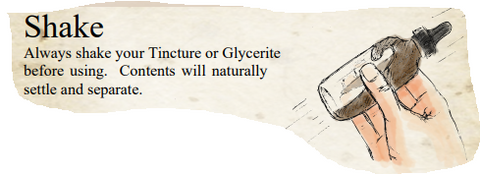We hope that you enjoyed our recent blog about the production of tinctures and glycerites.

The Basics
The standard protocol for using liquid herbal extracts is to "shake it before you take it" as we like to say around here. Tinctures (and Glycerites) will naturally settle and separate, which this is different from falling out of solution. When a Tincture settles, there may be a sludge or some goo at the bottom of the bottle that will reincorporate upon shaking the bottle. When a product falls out of solution, solid particulate will fall to the bottom of the bottle and stay solid, even after shaking vigorously. Demulcent herbs, such as Marshmallow, may take extra or prolonged shaking to fully incorporate the mucilage.
The standard method for taking liquid extracts is to take herbs by the dropper-full (about 1 milliliter of Tincture) orally. Typically this dose is taken on or under the tongue, but may also be mixed with juice, water, tea, or any other preferences. Caution when mixing tinctures with creamy substances as the herb or alcohol may cause the cream to curdle (and most herbs don't have the best flavor to be mixed with certain foods).

What we often recommend is to take your dose and then chase it with water - you get your dose and the flavor of the herbs (it is important to understand the different flavors and their associated actions), without having to choke down overly-strong alcohol. And no need to worry, the dilution of the tincture with a swig of water will not change the effectiveness of the herbs. We also recommend that customers take their tinctures with a meal, not that it is necessary, but it helps with people that have sensitive stomachs and it also reminds someone to take their herbs at least 2-3 times per day.

Getting Creative
While I spend lots of time in Prairie Star’s manufacturing lab, I can also step back and appreciate the many ways, some unconventional, that I can use these herbal extracts.
Here are a few:
I’m fond of using tinctures externally. Technically, this transforms your tincture into a liniment. When I have a neck ache (I hold a lot of tension here), I grab my blue vervain tincture. I may put a few drops in my hand, and rub it into the painful spot. I may also take a ½ dropper internally. Blue vervain is a nice remedy to relax tense muscles by calming the nerves and relieving spasms, especially in the neck area. It’s also one of our favorite bio-regional plants, and looks beautiful in a prairie garden.
I also use tinctures to flavor foods and drinks. If you think about it, our familiar vanilla extract that sits on the kitchen shelf is actually a tincture – it’s made in the same way that we make our tinctures. I’m fortunate that I get to taste EVERY tincture that we make. There are a few that really get my attention. He shou wu is a Chinese herb – when tinctured it is dark and thick, and has a rich, sweet aroma and taste. Used in TCM to promote longevity, I often use it instead of vanilla in cakes and frostings. It imparts that really pleasing, caramelized taste that adds something special.

I’m also fond of using tinctures in mocktails – I might use gentian, ginger and orange peel, along with a bit of honey, adding it to sparkling water, as a nice bitter drink to sip while I wait for rice to finish cooking for my dinner.
Lastly, I might add a few drops of a tincture (like peppermint, or cardamom) to my tea, or roasted roots blend, along with some oatmilk, then froth a bit for a nice relaxing after dinner drink. Or maybe an energizing drink of green tea and a dropper of PSB’s “sharp as a tack” formula for a mid afternoon boost.


Leave a comment